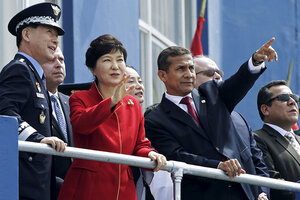Month-long protest over Peru copper mine claims first life
Twelve other protesters were wounded when police opened fire on a demonstration against the Mexican-owned project.

Peruvian President Ollanta Humala with South Korea's President Park Geun-Hye at a military airbase in Lima on Tuesday. Humala's government has pushed hard for the Tia Maria mine.
Lima, Peru
Mourners carried a coffin holding a 61-year-old farmer through the streets of a southern Peru port city Thursday after the man became the first fatality of a monthlong protest against a Mexican-owned copper mining project.
Agriculture Minister Juan Manuel Benites, the chief government negotiator in the dispute, said the widening protest against the Tia Maria project put at risk Peru's reputation as a top foreign investment destination.
Farmer Victoriano Huayna was killed Wednesday and 12 other protesters were wounded when police opened fire on a demonstration, authorities said.
A forensic exam determined a bullet killed Huayna, said a local doctor who agreed to reveal the information only if not quoted by name for reasons of personal security. The other 12 were wounded by shotgun pellets, local health director Walter Vera said. He said six were hospitalized and six treated and released.
A police statement said 11 officers were injured during the protest and added that officers had orders not to use lethal force.
Mine opponents marched with Huayna's coffin in the city of Mollendo, some carrying green banners reading: "Farming, yes. Mine, no."
Farmers and local leaders fear the $1.3 billion Tia Maria open-pit mine will contaminate irrigation water in the rice farming-rich Tambo valley on Peru's desert coast. Thousands have mobilized against the project, which is owned by Southern Peru Copper Corp., a subsidiary of Grupo Mexico.
Southern calls the crop damage fears unfounded, saying it plans to use desalinated Pacific Ocean water to process the copper and then pipe the water back into the ocean.
Mr. Benites, the agriculture minister, told RPP radio that the Tia Maria conflict puts "at risk not just a single mining project but Peru's reputation as a country that can attract responsible investment."
President Ollanta Humala's government has pushed hard for Tia Maria, which would yield 10,000 tons of copper daily over 18 years. Its environmental impact plan was approved last year.
The Andean nation depends on mining for 62 percent of its export earnings, and Peru's leaders have offered region-leading incentives over the past two decades to attract investment. The country is now the world's No. 3 copper producer and No. 5 in gold.
Total investment in mining last year in Peru amounted to $8.6 billion, according to official figures.
But Peru's poorest tend to live in the shadow of its biggest mines, and contamination fears fuel protests. In 2011, three farmers were killed during protests against Tia Maria. Another major mining project stalled since 2011 is Conga, majority owned by U.S.-based Newmont Mining Co. Police killed five people in 2012 during protests against that open-pit gold project.

